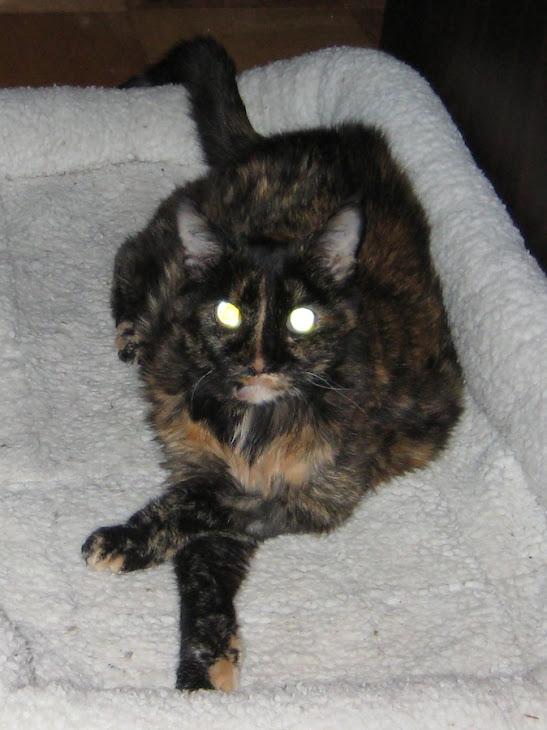Do Cats Need Fiber, Too?
Cats are
obligate carnivores, meaning that meat must be the primary ingredient in their food. But just as our doctors advise us to eat fiber, it's also an important part of your cat's diet.
In the wild cats eat prey, and they eat all portions of that prey. That includes not just the meat (muscles), but organs, hair, bones, feathers...each of which provides nutrients of value to the cat. Hair and feathers are natural types of fiber found on prey that are not present in our modern-day canned or dry cat foods.
You may have noticed that your cat will eat grass sometimes. This is helpful to kitty in passing hairballs and in adding a little fiber to the diet. You'll even find kits for growing cat greens, which are healthy for your cat to consume and have the added advantage of keeping kitty from dining on your houseplants.
Increasingly, you may have also noted the appearance of something called "
prebiotics" in your cat's food.
Fussie Cat is a brand we've recently added on OldMaidCatLady.com that contains them. What are prebiotics, and why does your cat need them? Are they different from "probiotics"?
Prebiotics are actually a form of fiber, but a very specialized type. They encourage the growth of helpful bacteria called microflora (or
probiotics) in the intestines. These include Bifidobacteria and Lactobacilli. A healthy population of "good" bacteria in your cat's intestinal tract will inhibit the growth of "bad" bacteria - the kinds that cause disease.
Prebiotics have been used as human supplements in Japan for many years and are gaining fans in Europe. But they're only starting to catch on here in the U.S. as human supplements. So why are they important for your cat?
Fructooligosaccharides (FOS) and Cats
There are actually different types of prebiotics. One class is called "fructooligosaccharides", which is a mouthful of word in itself! Other names for it are oligofructose or oligofructan, and it's often abbreviated as
FOS. It's essentially a plant sugar linked in chains and occurs naturally in asparagus, Jerusalem artichokes, bananas, garlic, chicory root, tomatoes, wheat, and soybeans. Not exactly cat-favored foods, right?
The beneficial thing FOS does is provide a place, or substrate, for healthy bacteria to grow in the large intestine. Studies have shown its effectiveness in
improving calcium and magnesium absorption. It's used to
combat both constipation and diarrhea, as well as lowering
cholesterol levels. Anecdotal evidence shows that it is also effective in
preventing yeast infections.
All things in moderation, however: in addition to feeding the good bacteria, too much FOS can give pathogens -- the "bad" bacteria -- a growing place, as well. It's important not to go overboard with it and give your cat too much. Make sure you buy a brand of food carefully prepared to include the correct amount. And it is not recommended for cats suffering from any type of bacterial infection.
Some cats may also have an
allergy to FOS. If you switch to a food with FOS and notice your cat experiencing flatulence, bloating, apparent abdominal pain or cramping, and diarrhea, go back to the old food you were feeding without it, because it's not the right solution for your cat. Cats with loose stools may not adapt well to any addition of FOS to their diet.
Galactooligosaccharides (GOS) and Cats
The galactooligosaccharide, or GOS, type of prebiotic is produced by enzymatic conversion of lactose, or milk sugar. It is sold as a human supplement widely in Japan and increasingly in Europe, usually in a syrup or powder format.
Studies done on GOS show the same benefits as with FOS, especially early in life. They have increased the resistance of human infants to respiratory infections when added to the diet during the first two years of life. But does this benefit carry over to cats?
Several university studies on prebiotics fed to cats showed that a diet with added FOS and GOS together has improved digestibility for cats. It also
increases beneficial bacteria and
short-chain fatty acid concentrations. All the studies have concluded that low-level supplementation of FOS and GOS have a positive effect on "gut health" in cats.
So what's up with the "short-chain fatty acids"? Those are important because they are a source of energy for the cells lining the colon. SCFAs also help your cat maintain balance of fluids and electrolytes, help food to move through the intestines, combat inflammation, and help maintain the normal structure of the colon.
Trans-galactooligosaccharides (TOS) and Cats
Also a part of milk, TOS is included in some kitten formulas. It provides many of the same benefits as GOS: improved digestibility and good intestinal health.
So yes, your cat does need fiber! Help your kitty stay healthy by making sure he gets the right amount.











